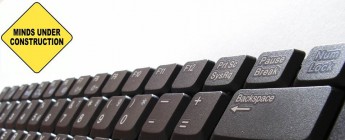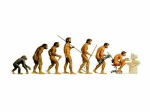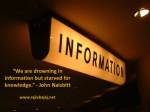After having watched all the four suggested videos posted under Popular Cultures, I am still trying to analyze my thoughts on the Utopian as well as Dystopian views on technology, as depicted in the videos.
Being a lover of computers as well as technology, my approach to technology has largely been utopian and I doubt whether I would ever lean towards the dystopian side – mostly. That having been said, one is also reminded of the old adage – Every coin has two sides. From that perspective, I must also respect the dystopian supporters, while holding on to my own beliefs.
While each one of the videos has been thought provoking in its own way, let me discuss them here one by one.
As I pen, or rather, type my thoughts on to this particular video, I am reminded of another MOOC that I just completed on Coursera – Foundations of Virtual Learning. The instructor had shared some rather interesting facts on that course, which i am repeating here.
Virtual instruction began as a “disruptive technology”, which according to Kanna and Gillis is a technological innovation that improves a product or service in ways that the market does not expect. Disruptive innovations tend to become the norm within a new market or arena of competition due to being simpler and more affordable than existing products. Then the innovations begin to handle more complicated problems, and take over and replace the old way of doing things. Computer-based learning became popular for flexibility in higher education, high school Advanced Placement (AP) classes, rural schools with a shortage of courses or qualified teachers, urban schools in low-income areas, and homeschooling families.
“Taking our current model of a one-size-fits-all education and delivering it from an online-learning school platform or other cutting-edge digital delivery method is like taking a Model T, adding new tires, and hoping it will fulfill the needs of car drivers today,” (Kanna & Gillis, 2009). This is a short-sighted attempt at leveraging the benefits of technology for education.
One fact about technology that is worth repeating is that newer technology is always around the corner. What is good today may soon get outdated and trashed. What we “worship” today may soon be replaced with something more advanced and more fancy. Great ! Anything that improves the way we currently do things is more than welcome.
But that raises the next big – and very valid – question – what about the social & ecological impact ?
The social impact of technology is something that we are currently living and experiencing. What was a menial task a few years ago is something that is routinely automated today. Which means that more and more humans are now turning to technology for solutions to daily life routines. But at the same time more and more people are losing jobs because of automation of processes. That is the “other” side of the coin that needs to be tackled. Are we training people adequately to cope with technological changes, or are we letting them become redundant ?
Another social impact is that we are now more connected, and the internet is shrinking the world. We are literally drowning in information. And the result is that we are now “addicted” to being connected, especially in the social space. Such is this obsession that we often find people sitting in the same room exchanging IM’s instead of taking face to face ! Below are a couple of images which, perhaps, highlight the social impact of technology.
And now the ecological impact. Are we creating a technology dump that we will not be able to handle if it is allowed to grow too big ? Are we simply focusing on the benefits of newer technology, with no thought as to what we should do to the one discarded ? The obvious answer is recycling, but the question that then arises is – are we recycling enough ? Are we recycling at a rate that is keeping up with the intake of new technology ? Food for thought there. Are we able to balance our desire for new technology with the preservation of our ecological systems ?
The second video, Inbox, is described in the Weekly Resources as “a quirky representation of the ways in which web-based technology connects people.” I couldn’t agree more with the very apt word used – quirky. And totally utopian. Now this is one area where I tend to agree with the dystopian advocates. 🙂
True, web-based technology connects people. Or does it ? In my view, it only connects the “profiles” and not the individuals. What one learns about the other is what the other would have you believe. The online world is a big-bad-world in this respect. People tend to believe that they are totally anonymous on the internet, and due to this they choose, sometimes, to project a “profile” that may be far removed from reality. The nature of communication in such a relationship would then border on falsehoods. One reads so much about all kind of things happening when people meet online, so this video and its ending is truly utopian – the kind that one may wish for but may never get. This is why it pays to be cautious about who you are interacting with online, and to what extent. As they say, better safe than sorry.
More on the videos tomorrow….





Some very interesting observations, Rajuv. I particularly like how you put your argument about “InBox”. To be honest, it also made me think about the rising problem of cyber-safety. But then I decided to concentrate on the video itself and concentrated on “prasing the positive side of it” in my blogpost. In the end of the day, they might want to demonstrate how the things could be, at least if all the users would choose to use communications technologies “for good reasons”. I see it as another warning regarding human responsibility to be “good” rather than blaming technology for all the wrong consequences. Very utopian ideal, I know, but… I wish that could come true. 🙂
LikeLike
Thank you, Liliya. Actually this was one of my initial posts, and I guess I was still getting used to analysing videos then, and perhaps did not go into the depth that they deserved.
In fact, when I thought a bit more about this one later, it occurred to me that there was so much more that could have said about it. For example, the torn bag signifying the disruption in communication. And then later, when the two meet face to face, there is an awkwardness, which would be natural for anyone having been used to communicating in the virtual world.
But utopian or not, I still liked this video 🙂
LikeLike
Reblogged this on The MOOCs Explorer.
LikeLike